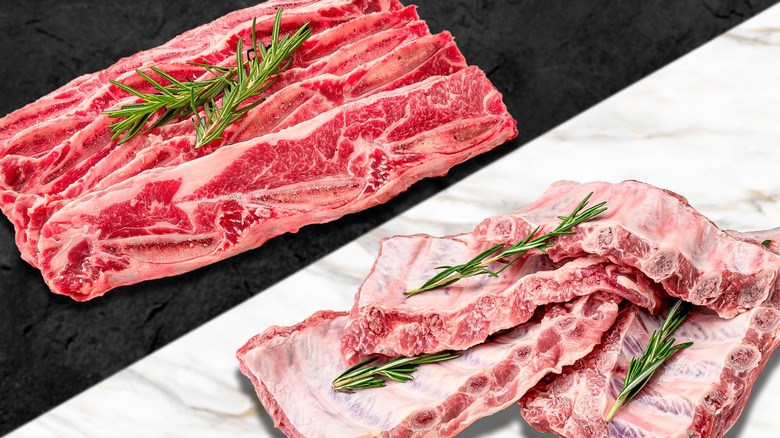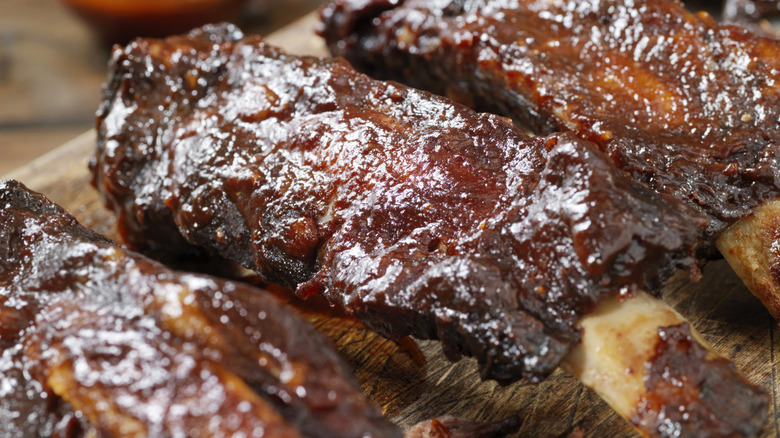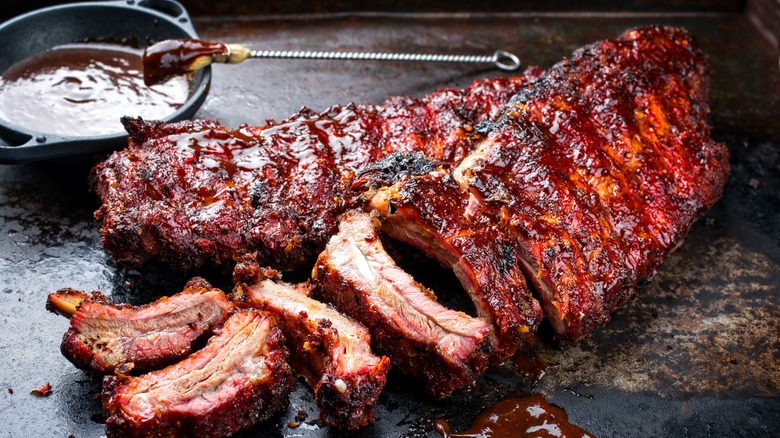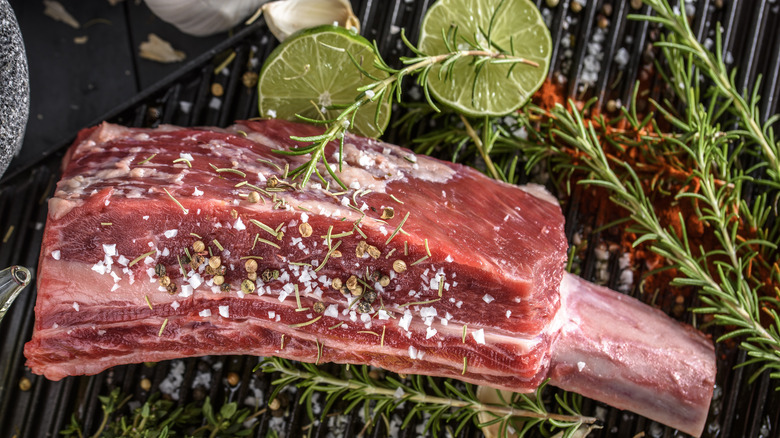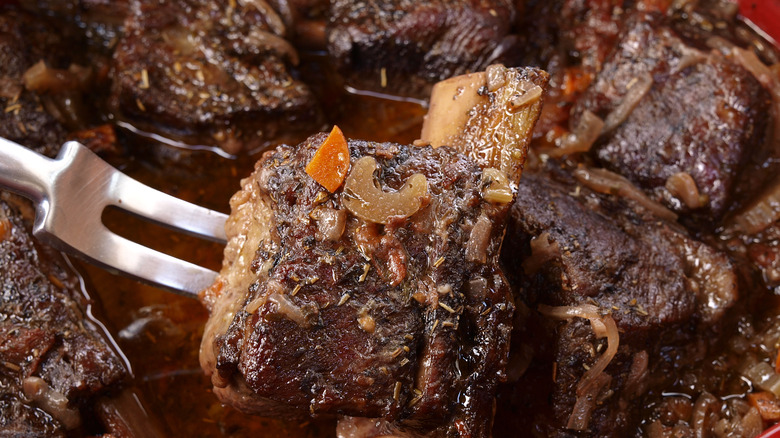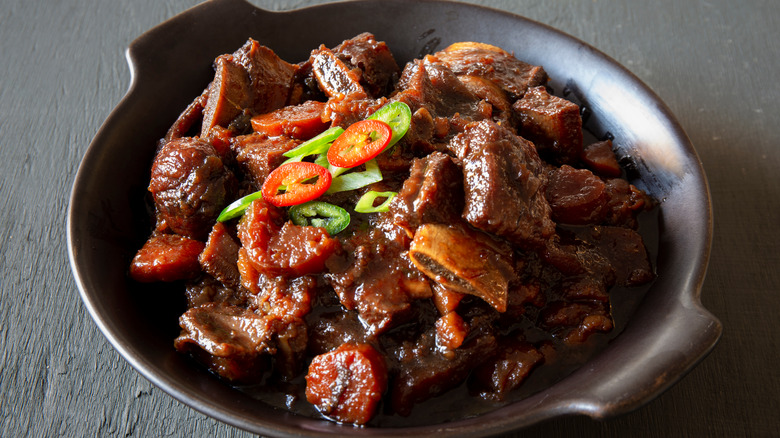The Fatty Difference Between Beef And Pork Ribs
While there's considerable appeal to a steak or roast, few cuts lend more hands-on fun than a plate of ribs. Biting tender morsels of meat off the bone with a perfectly paired tasty sauce or rub is a good way to eat. Plus, the varying types and styles of ribs encompass many meat products, from tender beef short ribs to pork rib tips.
So it's helpful to consider how the source animal impacts preparation. Pork and beef ribs are both flavorful cuts, but with clear distinctions. Most fundamental are the contrasting fat quantity and the size. Beef ribs comprise a much heftier piece of meat, with each bone often more than twice the length of its pork counterpart. They're also complemented by more fat, typically marbled and layered throughout the meat. This fat infuses the cut during cooking, leading to a tender and bold result.
Conversely, pork ribs come as a whole rack, with a uniform distribution of three to six-inch bones. Their flavor is balanced and only slightly porky. They're a familiar candidate for slow cooking, and also taste great on the grill, making them the delightful and juicy BBQ rib of choice for most.
What are beef ribs?
With meat spread across a 13-bone rack, beef ribs comprise several different cuts. They're divided into three principal rib regions: chuck, plate, and back. Beloved short ribs, which are sometimes served and cooked without the bones, come from these first two regions — the chuck and plate. Covering the first ten bones, these cuts have many names among butchers.
They can be sliced down individual bones into flanken, and English cut ribs, as well as Korean-style butchering. Alternatively, each region can kept as a whole slab for a more traditional rib structure. And to enable easier preparation, ribs are often halved lengthwise. In addition to short ribs, the middle plate section also yields the beautifully trimmed tomahawk steak, which is best prepared like other steaks.
However, classic BBQ-designated beef ribs are sourced from the back. Accordingly named back ribs, this rack is lighter on meat but heavier on fat. As a result, it's an ideal match for slow-cooking.
What are pork ribs?
As opposed to beef ribs, pork ribs have fewer cuts. All are served as a long rack, with interspersed bits of fat, cartilage, and bone bits. They're typically delineated into three types: baby back, St. Louis-style, and spare ribs.
The leanest is the large curved baby back, derived from the upper ribs next to the tenderloin. With tasty pork meat wrapped around thin bones, they're ideal for low and slow cooking methods, especially smoking. A postcard of pork ribs, they're the meat cut you'll want to prepare with the tender 3-2-1 barbecue method.
Alternatively, spare ribs are from lower down, just above the fatty pork belly, and have more fat and flavor than other offerings, although at the expense of more cartilage and other offcuts.
If you're looking for a tidier version of this rib cut, turn to St. Louis style ribs. The cartilage and fat are cut away, leaving a perfectly shaped rib rack ready for a slew of applications. With some fat content, these can also be grilled or baked.
While grilling is a particularly beloved option for all pork ribs, all three are poised for a range of tasty cooking methods and recipes.
Pork and beef ribs contain different fat contents
Especially in slow-cooked applications, the fat content is the two cuts' largest differentiator. Despite pork's generally plump constituency, the ribs are a lean cut. There's some variance among the three rib types, as well as the pork breed, but only the rib tips are particularly fat-heavy. As a result, the flavor of pork ribs isn't aggressive, and can be reminiscent of pork chops. However, there is enough fat for the meat to be juicy.
Their beef counterpart is far fattier. Whether it's chunks of short ribs or a rack of bone-in dino ribs, it's easy to spot dense accumulations of fat. Found both on the exterior and interspersed throughout the meat, it's characteristic of the meat. It's also an essential flavor quality of the beef; the fat cooks down and gives it its bold taste. With the wrong cooking method, this density of fat may complicate things. However, particularly with slow cooking, there's an unquestionably appetizing allure to the tender, brisket-like meat of cow ribs.
Beef ribs work with more diverse cooking methods
As a continuous rack, pork ribs are relatively constricted in their preparation potential. However, they execute perfectly when smoked as a whole rack, baked in the oven, or cooked on the grill. And for many, it's all about what they're seasoned with. Their milder flavor is easily enhanced, whether it's just down to the wood chips used, a creative coating of chili and cider glaze, or a simple dry rub. However, due to their smaller size and bone density, they're infrequently broken down into smaller pork products.
On the other hand, beef ribs expand to numerous cooking applications. Short ribs offer a treasure trove of recipes. Beyond the classic braised in red wine recipe, the cut performs well with a quick sear, too, producing rarer morsels of meat ready to slice up and top salads, bowls, and noodles.
Plus, there are classic steaks derived from the ribs — aptly named ribeye, but also tomahawk. Not to mention the delectable roasted prime rib which is used for roasting, and also hails from this section of the beast, showcasing the region's versatility. These may seem a far cry from ribs altogether, but all come from the rib area of the animal.
Each cut takes on a distinct culinary tradition
While both pork and beef ribs are tremendous in classic American applications, they are used in many global recipes, too. In Asian cuisines, pork ribs are frequently braised. Korean maeun dweji galbijjim slowly cooks the cut to tender perfection in a spicy pepper sauce. Alternatively, Chinese cuisine boils the ribs and then finishes them in a sweet and sticky glaze. And in Thailand, pork ribs are slow-roasted in an aromatic sauce, for a chewy consistency.
Especially with short ribs' malleability, beef ribs encompass diverse culinary styles. From spice-heavy beef rendang to a French-style braise in red wine or Pakistani nihari stew, which uses ribs or shank, beef ribs have delicious renditions all over the world.
East Asian preparations showcase the quick-searing possibilities of ribs. L.A. style galbi is a specific variety of beef short ribs butchered for the grill, marinated, and quickly seared over charcoal for a round of Korean BBQ. Similar preparations also take place in Japan, showcasing the diverse preparation possibilities for beef ribs.
